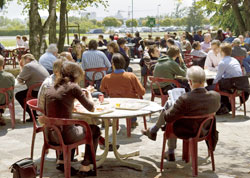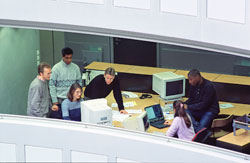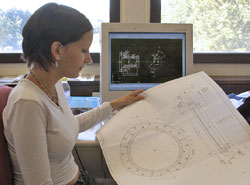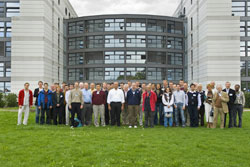CERN: a unique experience
The following essay has been written by Egil Lillestol a particle physicist from the university of Bergen (Norway) after many years of experience at CERN in, among other activities, collaborating in one of the LHC experiments...
 On a first visit, CERN gives the impression of a huge industrial complex. The buildings crowd untidily around the large machines devoted to the production of high-energy particles. It is in the restaurants that a visiting scientist discovers the true flavour of CERN, along with the Swiss cooking. At surrounding tables animated discussions about high-flown theories, intricate experiments, or the best places for skiing, are going on in half a dozen languages, with Broken English predominant. Physicists from many lands, dressed informally for hard work, forge friendships over their hurried meals.
On a first visit, CERN gives the impression of a huge industrial complex. The buildings crowd untidily around the large machines devoted to the production of high-energy particles. It is in the restaurants that a visiting scientist discovers the true flavour of CERN, along with the Swiss cooking. At surrounding tables animated discussions about high-flown theories, intricate experiments, or the best places for skiing, are going on in half a dozen languages, with Broken English predominant. Physicists from many lands, dressed informally for hard work, forge friendships over their hurried meals.
With experience, one begins to take such things for granted which may be a pity, because there is nothing quite like CERN anywhere else on Earth...
Lost in the crowd?
Even in larger countries, there are many small University groups. Will a visiting physicist from a small group be lost in the crowd at CERN? Or can she or he make a significant contribution to the huge enterprise?
 The answer is undoubtedly positive: a bright idea for an experiment may come from any individual of any nationality, and proposals are accepted or rejected essentially on scientific grounds.
The answer is undoubtedly positive: a bright idea for an experiment may come from any individual of any nationality, and proposals are accepted or rejected essentially on scientific grounds.
On the other hand the building, running and analysis of an experiment can often be done more efficiently within a larger group having good access to workshops, computer facilities and high level support staff. In this, CERN’s own physicists can have an advantage over the visitors. Even physicists from the larger national groups have sometimes felt overshadowed by strong CERN-based groups, and this has led to numerous heated debates.
Sharing the load
In earlier years, this problem was tackled by building general experimental facilities at CERN for which most of the work of data analysis could be done at the physicists' home institutions. A classic example was the bubble-chamber experiments, in which pictures taken at CERN were measured and analysed at home.
Later on, with some of the larger experiments using electronic detectors, CERN’s physicists unavoidably played a dominant role. But now the situation has changed. CERN had to spend much of its budget on building new machines such as the Large Electron-Positron Collider (LEP) and now the Large Hadron Collider (LHC). As a result it could contribute less than 20 per cent to the cost of the big LEP experiments, and even less for LHC. The rest is contributed by the various institutions collaborating on the experiment.
In one sense, we all want CERN to dominate the scene, so that it attracts excellent physicists and engineers from all over the world. It does this by the quality of the research carried out at CERN and the continuous presence of numerous visitors from the CERN member states and now the rest of the world.
Physicists from the corners of Europe can stay in constant touch with the best global research, and even influence its progress, as we rub shoulders with European and American Nobel prizewinners, and with Chinese and Russian particle physicists.
World-wide projects
This international goodwill is all very well, but when an experiment is split up and built by a large number of institutes, spread across Europe and other continents, efficient co-ordination is essential.
Take just one example: ATLAS, which is one of the big experiments built for the LHC. A mass of particle detectors is packed into an assembly that weighs 7000 tonnes in all. ATLAS is one of the largest collaborative efforts ever attempted in the physical sciences.
There are 1800 physicists (including 400 students) participating from more than 150 universities and laboratories in 35 countries: Argentina, Armenia, Australia, Austria, Azerbaijan, Belarus, Brazil, Canada, China, Czech Republic, Denmark, France, Georgia, Germany, Greece, Israel, Italy, Japan, Morocco, Netherlands, Norway, Poland, Portugal, Romania, Russia, Serbia, Slovakia, Slovenia, Spain, Sweden, Switzerland, Taiwan, Turkey, UK, USA CERN and JINR.
And the physicists taking part are supported by a large number of high-level technicians and engineers. This obviously requires a high level of organisation, while still giving everyone the chance to make their views heard.
Spreading the know-how
The fact that CERN now plays a smaller role than usual, so that more of the detector components are developed, tested and built by the outside groups, has been excellent for universities, because teaching and detector development can be combined.
 University scientists can spend more time at their home institutions, and more research students can be involved in the advanced technology. When local manufacturers take part, either in development work or in mass production of the final components, links are formed and strengthened between industry and research groups, and eventually with CERN.
University scientists can spend more time at their home institutions, and more research students can be involved in the advanced technology. When local manufacturers take part, either in development work or in mass production of the final components, links are formed and strengthened between industry and research groups, and eventually with CERN.
The huge experiments also create contacts between industries in different countries leading to the creation of networks and stimulating the general advancement of technology in Europe. Also, students acquire first-hand knowledge of industry, and they often leave to take up an industrial career. That too is good for industry, although the loss of a valued young collaborator may be painful for the research group. The research students who finish up helping to run an experiment at CERN are particularly fortunate.
Besides tackling some of the deepest questions in science, they gain valuable experience in coping with a multitude of technical problems, learn to work in a multinational environment and often acquire one or more foreign languages for free. But many of the students move on long before an experiment is complete.
A long haul
The large experiments at LEP and now the LHC experiments have a rather long life span. Close to ten years have been needed in development, planning, design, construction and finally assembly of the detector systems to be ready for data taking in 2007, and it is expected that the LHC-experiments will be running for 10 - 15 years...
There are disadvantages when an experiment spans such a long period. In the construction phase the emphasis is on technology, while in the running phase data-handling and interpretation of the physics results predominate. Yet there is plenty of good physics in detector development, and furthermore much of one's time is spent in following new theoretical ideas in particle physics, in order to optimize the detectors for testing the ideas experimentally and perhaps make an important new discovery!
A rocky road?
There are of course human problems, too. The sheer size of a collaboration at CERN adds a new dimension to the life of physicists, who may sometimes feel that they are also taking part in a sociological experiment. Many researchers find it difficult to adapt to the requirements of a huge enterprise.
It is not always easy to accept that one's brilliant new idea for an improved detector cannot be incorporated due to lack of money or time, or that the collaboration as a whole may arrive at a decision against the wishes of the individual or his group.
In the course of the wrangles, the collaborators gain experience going far beyond the limits of science. They learn, for instance, that a line of argument may take on quite different meanings when presented by physicists from different nations, and that working habits and priorities vary markedly from one country to another.
In the melting pot of such a collaboration, lifelong friendships are formed irrespective of national boundaries, and insight into the different cultural and political backgrounds of the participants leads to an understanding of their strengths and weaknesses.
Science across frontiers
 CERN in general, and the huge experiments in particular, involve a multitude of people with different backgrounds, priorities and interests. Is this way of doing things the most efficient? No doubt we could point to cases where CERN could have operated more efficiently.
CERN in general, and the huge experiments in particular, involve a multitude of people with different backgrounds, priorities and interests. Is this way of doing things the most efficient? No doubt we could point to cases where CERN could have operated more efficiently.
Yet the chief business of physics is new ideas, and these may be born precisely in high-spirited discussions where people with varying cultural backgrounds view problems in unexpected ways. The new ideas may be just what are needed to advance the frontiers of knowledge. There is therefore no reason for surprise that Europe, largely through the medium of CERN, has gradually recovered a leading role in fundamental physics, as it had before the Second World War.
The laws of nature are almost the only ingredient of human culture that are more or less safe from ideological differences, and people from all over the world work peacefully together at CERN, towards a common goal: a deeper understanding of the material world.
This may be even more significant than the discoveries in physics, if such international co-operation helps, in the long run, to create better relations between nations, and to rid the world of the dangers threatening the existence of the civilisation that fosters our science. In that sense, the polyglot restaurants at CERN seem to be as important as the big accelerators.
 CERN in general, and the huge experiments in particular, involve a multitude of people with different backgrounds, priorities and interests. Is this way of doing things the most efficient? No doubt we could point to cases where CERN could have operated more efficiently.
CERN in general, and the huge experiments in particular, involve a multitude of people with different backgrounds, priorities and interests. Is this way of doing things the most efficient? No doubt we could point to cases where CERN could have operated more efficiently. 

 On a first visit, CERN gives the impression of a huge industrial complex. The buildings crowd untidily around the large machines devoted to the production of high-energy particles. It is in the restaurants that a visiting scientist discovers the true flavour of CERN, along with the Swiss cooking. At surrounding tables animated discussions about high-flown theories, intricate experiments, or the best places for skiing, are going on in half a dozen languages, with Broken English predominant. Physicists from many lands, dressed informally for hard work, forge friendships over their hurried meals.
On a first visit, CERN gives the impression of a huge industrial complex. The buildings crowd untidily around the large machines devoted to the production of high-energy particles. It is in the restaurants that a visiting scientist discovers the true flavour of CERN, along with the Swiss cooking. At surrounding tables animated discussions about high-flown theories, intricate experiments, or the best places for skiing, are going on in half a dozen languages, with Broken English predominant. Physicists from many lands, dressed informally for hard work, forge friendships over their hurried meals.  The answer is undoubtedly positive: a bright idea for an experiment may come from any individual of any nationality, and proposals are accepted or rejected essentially on scientific grounds.
The answer is undoubtedly positive: a bright idea for an experiment may come from any individual of any nationality, and proposals are accepted or rejected essentially on scientific grounds.  University scientists can spend more time at their home institutions, and more research students can be involved in the advanced technology. When local manufacturers take part, either in development work or in mass production of the final components, links are formed and strengthened between industry and research groups, and eventually with CERN.
University scientists can spend more time at their home institutions, and more research students can be involved in the advanced technology. When local manufacturers take part, either in development work or in mass production of the final components, links are formed and strengthened between industry and research groups, and eventually with CERN.